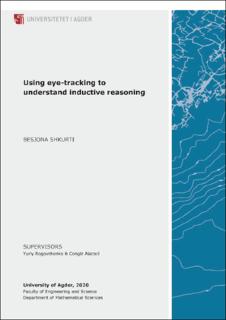| dc.contributor.author | Shkurti, Besjona | |
| dc.date.accessioned | 2020-10-01T07:45:06Z | |
| dc.date.available | 2020-10-01T07:45:06Z | |
| dc.date.issued | 2020 | |
| dc.identifier.citation | Shkurti, B. (2020) Using eye-tracking to understand inductive reasoning (Master's thesis). University of Agder, Kristiansand. | en_US |
| dc.identifier.uri | https://hdl.handle.net/11250/2680623 | |
| dc.description | Master's thesis in Mathematics education (MA500) | en_US |
| dc.description.abstract | This master thesis explains the work done to answer three research questions which are re-lated to the understanding of inductive reasoning in solving shape pattern tasks. A short introduction presents the topic of the thesis, the research questions, the challenges faced during the pandemic, the related effects on the quality of the thesis and main discover-ies.An analysis of related literature was done in order to link this research with previous theory in the field of math reasoning, especially inductive reasoning and eye-tracking method to collect and analyse the data. This has served to shape the research design. The methodology chapter includes the research design, who are the subjects and how they were chosen. It presents the materials and instruments that helped to collect and analyse the data, the method chosen for data collection and the ways these data are analysed. This chapter ends with a brief discussion of the ethical consideration, validity and reliability issues.This is followed by the chapter of analyses and results which shows detailed analyses of col-lected data and the results which constitute the main value of this research. Strengths and limitations are presented in a separate chapter in order to give an idea to the reader of what the strong points that gave value to this study are and what could have gone better. These considerations help future researchers who may want to replicate this research by giving them a lot information about strengths and limitations. The discussion of the results with support in previous research is done in order to list the argu-ments that support the results of this research. The last chapter is of a particular importance as it presents the implication of the results in the field of mathematical education. The thesis ends with the list of figures and tables as well as references. | en_US |
| dc.language.iso | eng | en_US |
| dc.publisher | University of Agder | en_US |
| dc.rights | Attribution-NonCommercial-NoDerivatives 4.0 Internasjonal | * |
| dc.rights.uri | http://creativecommons.org/licenses/by-nc-nd/4.0/deed.no | * |
| dc.subject | MA500 | en_US |
| dc.title | Using eye-tracking to understand inductive reasoning | en_US |
| dc.type | Master thesis | en_US |
| dc.rights.holder | © 2020 Besjona Shkurti | en_US |
| dc.subject.nsi | VDP::Samfunnsvitenskap: 200::Pedagogiske fag: 280::Fagdidaktikk: 283 | en_US |
| dc.source.pagenumber | 95 | en_US |

